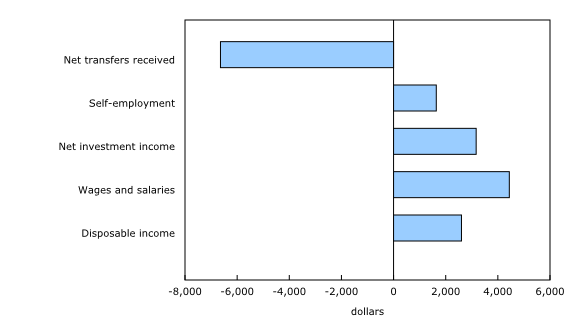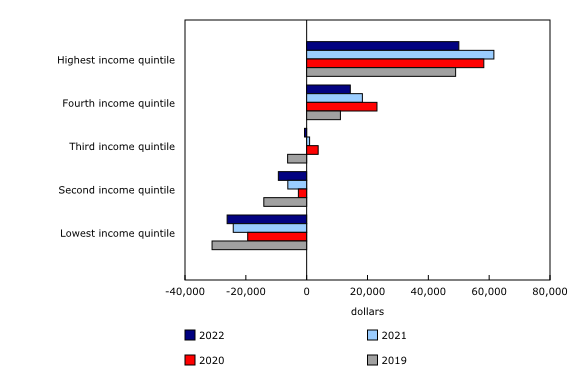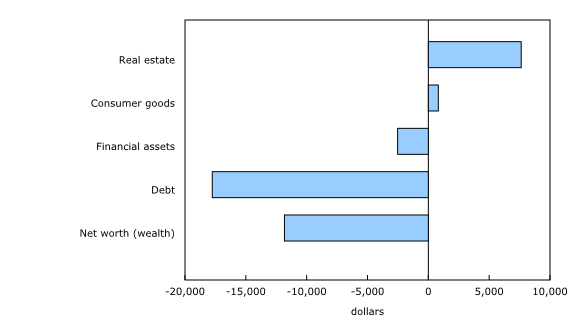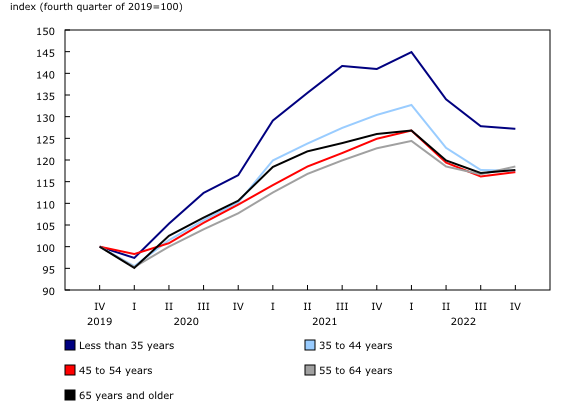Distributions of household economic accounts for income, consumption, saving and wealth of Canadian households, fourth quarter 2022
Released: 2023-03-31
Increases in the cost of living and declining asset values had a negative impact on net saving and wealth in 2022, especially for more vulnerable households, such as those with lower incomes, less wealth, and in younger age groups. Households in the second income quintile reduced their average net saving by 50.3% in 2022 relative to 2021, while at the same time average net worth declined at the fastest pace on record (-16.3%) for the bottom 40% of wealth holders and for those aged less than 35 years (-9.8%). Despite recent declines in economic well-being indicators for more vulnerable households, their net saving and wealth are still higher than before the COVID-19 pandemic.
Income gap narrows due to strong gains in employment income for lower income earners
Income inequality decreased in 2022 as the gap in the share of disposable income between households in the two highest and two lowest income quintiles declined by 0.3 percentage points relative to the previous year.
Households in the second quintile increased their income the most (+3.2%), mainly due to higher-than average increases in employment earnings. In contrast, disposable income grew at a slower-than-average pace for the lowest quintile (+1.6%).
Year-over-year gains in average wages and salaries for lower income households (+13.5%) were partially offset by lower transfers (-0.8%), mainly as a result of the expiry of pandemic-related government benefits, and higher interest payments (+4.3%) that weighed on net investment earnings. Borrowing became more costly for households as the Bank of Canada increased its policy interest rate to 4.25% at the end of 2022, up 400 basis points from a year earlier.
Highest income earners gain from employment income and investment earnings
Households in the highest 20% of income earners increased their average disposable income in 2022 relative to a year earlier at a slower-than-average pace (+1.4%). Gains in wages and salaries (+2.4%) and net investment income (+9.0%) were partially offset by reductions in transfers received (-12.8%), such as from reductions in Employment Insurance benefits, combined with an increase in the amount of taxes paid (+3.4%).
Net saving for lower- and middle-income households affected most by cost-of-living increases
Net saving decreased for households in each income quintile in 2022, as cost-of-living increases outweighed income gains. For the first time since before the pandemic, middle-income earners (third quintile) returned to negative net saving in 2022, meaning that, on average, these households spent approximately $700 more than they earned in income. The average net saving of households in the second income quintile decreased by 50.3%.
Although net saving reduced for households in each income quintile in 2022, it remained above levels recorded in 2019.
Households in each income quintile increased their spending on most goods and services over the last year, especially for food and accommodation services, clothing and footwear, and transportation.
Wealth gap widens, but remains lower than before pandemic
Due to a range of factors—including persistently high inflation, falling real estate values and volatility in financial markets—wealth decreased in 2022 for households, regardless of their level of wealth. Average household net worth was down 6.4% in the fourth quarter of 2022 relative to the same quarter a year earlier.
Most wealth is held by relatively few households in Canada. The wealthiest households (top 20%) accounted for more than two-thirds (67.9%) of net worth at the end of 2022, while the least wealthy households (bottom 40%) accounted for 2.6%.
The gap in net worth between the most and least wealthy households increased by 1.1 percentage points in the fourth quarter of 2022 relative to the same quarter a year earlier—the fastest increase on record for these estimates, which date back to 2010. In contrast, the wealth gap declined by 1.5 percentage points over the two-year period from the end of 2019 to the end of 2021. Despite recent increases in the wealth gap, it remained lower at the end of 2022 (65.3 percentage points) relative to the end of 2019 (65.7 percentage points).
The least wealthy households were affected more by recent economic pressures, as they decreased their average net worth by 16.3% in the fourth quarter of 2022 relative to the same quarter a year earlier, more than triple the rate of decrease for the wealthiest households (-5.2%).
In 2022, around two-thirds of the decrease in net worth for all households was due to real estate (66.1%). The average value of real estate held by households declined by 8.1% in the fourth quarter of 2022 relative to the same quarter a year earlier. According to data on home sale prices, the national average price for a residential home reached $625,000 at the end of 2022, down 12.1% from 2021.
Although the least wealthy bought real estate in 2022, their average net worth declined as the increase in mortgage debt to finance those purchases (+25.3%) outweighed the increase in the average value of their real estate holdings (+8.5%). On top of mortgage debt, the least wealthy also increased their non-mortgage debt (+10.4%), such as credit card balances, by more than other households.
In contrast, declines in average net worth for the wealthiest households were derived entirely by reductions in both real estate (-9.1%) and financial assets (-2.5%), while their debt remained unchanged in 2022 relative to 2021.
Wealth declines the most for households in younger age groups, due mainly to reductions in real estate
While average net worth decreased for households in each age group in the fourth quarter of 2022 relative to the same quarter a year earlier, it decreased the most for those less than 45 years, at about 10%, compared with less than 7% for those 45 years old and older.
Younger households tend to be more susceptible to reductions in real estate values, as they derive more of their net worth from that asset category, while older households have had more time over their life cycle to diversify their asset portfolio. The decline in real estate values in 2022 relative to 2021 accounted for 77% of the decline in average net worth for the youngest age group (less than 35 years old), compared with 60% for those aged 65 years and older.
Younger households reduce debt-to-income but increase leverage as asset values decline
Despite ongoing inflationary pressures, younger households decreased their debt-to-income ratios in 2022, due mainly to strong gains in employment income. The debt-to-income ratio for the youngest households (less than 35 years) reached 174.5% in the fourth quarter of 2022, down 5.2 percentage points from the same quarter a year earlier. In comparison, the ratio for those aged 55 to 64 years reached 161.2% in the fourth quarter of 2022, up 5.7 percentage points from the same quarter in 2021.
Younger households increased their leverage in 2022 from 2021, as measured by the debt-to-asset ratio, due mainly to reductions in the value of their real estate. The ratio for households in the youngest age group (less than 35 years old) reached 37.1% (+3.1 percentage points) in 2022, and those aged 35 to 44 years old reached 32.3% (+3.4 percentage points). An even larger increase in the debt-to-asset ratio occurred for the least wealthy, reaching 63.9% in the fourth quarter of 2022 (+8.6 percentage points) for the bottom 40% of wealth holders. Despite recent increases, debt-to-asset ratios remained below pre-pandemic rates for households across a broad range of economic and demographic characteristics.
Persistently high interest rates and inflation are likely to continue to strain households' ability to make ends meet without going further into debt, especially vulnerable groups, such as those with the lowest income, the least wealth and in the younger age groups. The latest figures from the Monthly Credit Aggregates program indicate that household credit card debt growth continued to accelerate up to the first month of 2023.
Sustainable Development Goals
On January 1, 2016, the world officially began implementation of the 2030 Agenda for Sustainable Development—the United Nations' transformative plan of action that addresses urgent global challenges over the next 15 years. The plan is based on 17 specific sustainable development goals.
The distributions of household economic accounts for income, consumption, saving and wealth of Canadian households are an example of how Statistics Canada supports the reporting on the Global Goals for Sustainable Development. This release will be used in helping to measure the following goal:

Note to readers
Statistics Canada regularly publishes macroeconomic indicators on household disposable income, final consumption expenditure, saving and wealth as part of the Canadian System of Macroeconomic Accounts (CSMA). These accounts are aligned with the most recent international standards and are compiled for all sectors of the economy, including households, non-profit institutions, governments and corporations along with Canada's financial position vis-à-vis the rest of the world. While the CSMA provide high quality information on the overall position of households relative to other economic sectors, the Distributions of Household Economic Accounts (DHEA) provide additional granularity to address questions such as vulnerabilities of specific groups and the resulting implications for economic well-being and financial stability. These estimates are an important complement to standard quarterly outputs related to the economy.
The DHEA estimates released today provide estimates of income, consumption, saving and wealth, including their sub-components by various household distributions up to the fourth quarter of 2022. Estimates have also been revised for prior periods to incorporate the latest CSMA benchmarks, including revisions for the first three quarters of 2022.
Estimates for net worth distributed by wealth quintile are combined for households in the lowest two quintiles for ease of illustration, since the average household in the lowest wealth quintile owed more in liabilities than it owned in assets, such as self-employed workers with negative net business equity and recent graduates with student loan balances.
As with all data, the DHEA estimates are not without their limitations. While some distributions are estimated using timely microdata or micromodels, such as wages and salaries and household debt, other distributions, including those for household final consumption expenditures, social transfers in kind and assets rely on assumptions or use data from prior reference periods. Users should keep these limitations in mind when analyzing the estimates included in this release.
All values are expressed in nominal unadjusted rates. As a result, the estimates presented in this release are not adjusted for variations over time that may occur due to seasonal patterns and/or price inflation.
Products
The data visualization product "Distributions of Household Economic Accounts, Wealth: Interactive tool," which is part of Statistics Canada – Data Visualization Products (71-607-X) is now available.
The article "Distributions of Household Economic Accounts, estimates of asset, liability and net worth distributions, 2010 to 2022, technical methodology and quality report," which is part of the Income and Expenditure Accounts Technical Series (13-604-M), is now available.
Details on the sources and methods behind these estimates can be found in Methodological Guide: Canadian System of Macroeconomic Accounts (13-607-X). See section "Distributions of Household Economic Accounts" under Satellite Accounts and Special Studies.
The Economic accounts statistics portal, accessible from the Subjects module of our website, features an up-to-date portrait of national and provincial economies and their structure.
The Latest Developments in the Canadian Economic Accounts (13-605-X) is available.
The User Guide: Canadian System of Macroeconomic Accounts (13-606-G) is available.
Contact information
For more information, or to enquire about the concepts, methods or data quality of this release, contact us (toll-free 1-800-263-1136; 514-283-8300; infostats@statcan.gc.ca) or Media Relations (statcan.mediahotline-ligneinfomedias.statcan@statcan.gc.ca).
- Date modified:





